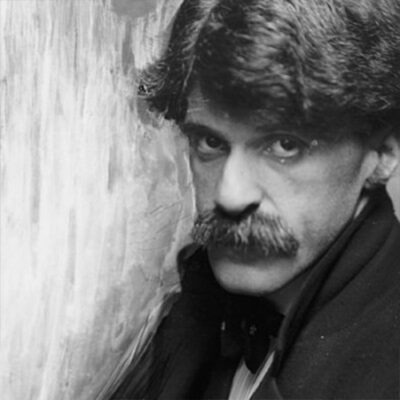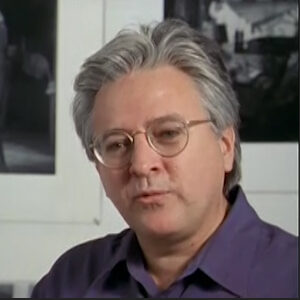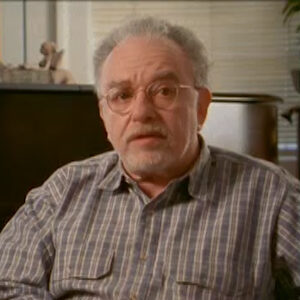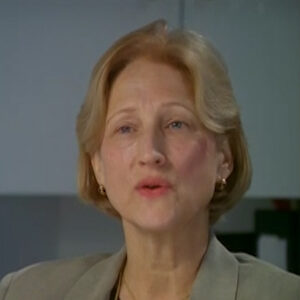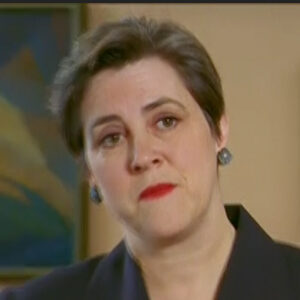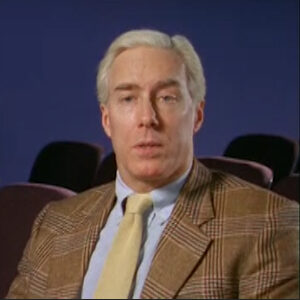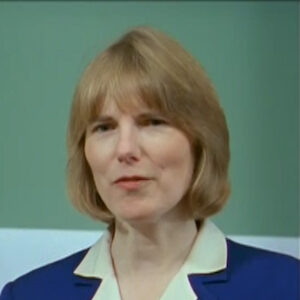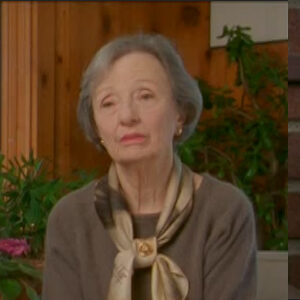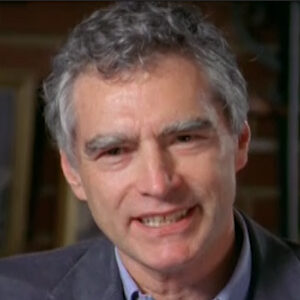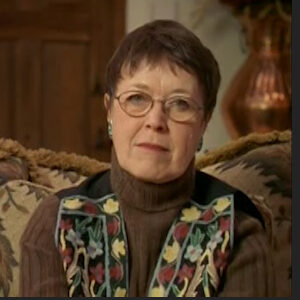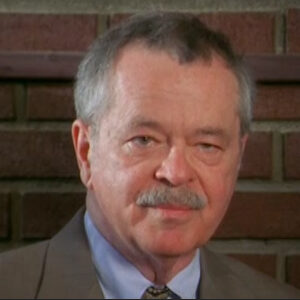Interviewer: Rudy Giuliani.
Interviewer: Could you tell me a little bit about just tell me the fact that Steichen had a number of countries.
Steichen: He had four or five or six.
Interviewer: I guess my question. So, yes. Here, Edwards. OK, yes.
Steichen: Yes. OK, well, Edward Steichen had four or five or six or seven careers, depending on how you want to count. He was a painter. He was a romantic who.
Steichen: He was someone who proved that photography was an art.
Steichen: He was a an army officer in charge of aerial surveillance photography for the United States Army in France in World War One. He was an experimenter in realism and symbolism and scale. In the early 1920s, he was a magazine photographer for Vogue and Vanity Fair in the 1920s and 30s. Then he had a career in charge of combat photography for the United States Navy in the Pacific and World War Two. Then he was the director of photography at the Museum of Modern Art. And in between all of this, of course, he created the large scale thematic exhibition that started with war exhibitions and ended with that wonderful humanitarian statement. The Family of man.
Interviewer: Yes, Virginia. I got the microphone 17.
Steichen: Edward Steichen had three or four or five or six or maybe a dozen careers. He started as a romantic, both as a painter and a photographer who was determined to prove that photography was an art. Then he became a realist who worked with scale and symbol. He became a magazine photographer who for Vogue and for Vanity Fair in the 1920s. In the 1930s. He had two military careers, one for the Army and World War One and recurrent aerial reconnaissance photography, one for the Navy in World War Two in combat photography in the Pacific. He was a plant breeder who introduced a new race of delphinium to the world. And after the Second World War, he was a museum curator who started the careers of many young photographers and recognized the careers of established ones. And in between all that, he created the thematic exhibition, which started with war exhibitions and ended with the family of Man, which was a great humanitarian statement, and Steichen plea for tolerance and understanding and peace among peoples loving.
Interviewer: Could you tell us sort of go back to the first career?
Steichen: Yes. Well, you don’t want that for it. Well, as a young man, Steichen was was a moody, romantic young man. He was also very determined. He was the child of an ambitious mother who was sure that her son would be great. And a family characteristic is the ability to focus relentlessly on what one has decided one is going to do. So he started in his teens with a camera. He was also a lithographer apprentice to lithography studio. He found a way to make practical use of photographs. Photographing the local livestock and convincing his boss that the this was a better basis for the lithographs than the highly stylized creatures they were drawing. But in his free time, he went out to the woods on the edges of Milwaukee and he photographed nocturnes. He particularly loved Twilight mysterious times. He would photograph a mud puddle and make it look like a wonderful pond or a lake. You know, it was mysterious things happening in it. He discovered that accidents produced marvelous tricks with the lens. He accidently kicked the tripod once that jiggle, that the lens that produced some blurs. So a raindrop fell on the lens. He discovered another kind of blur, which he could reproduce by spitting on the lens. He entered his photographs in the competitions that were available in Chicago and Philadelphia. His compositions were considered very unusual. He was obviously a bright, talented artist to follow. His career as a photographer was launched very quickly. At 21, he went to Paris to study art seriously. He stopped in a New York to meet statelets on his way. Stieglitz bought some of his photographs for know the enormous sum of five dollars, and Steichen for a while became Stieglitz as fair haired boy in Paris. Steichen spent a week in art school and then went out on his own. He became known wherever he went. He became known very quickly as a photographer. He would photograph. He would meet artists and famous people, writers. He would photograph them. They’d be quick, quickly became known as a marvelous portrait photographer. However, he earned his living as a painter until his 40s. His main source of income was his paintings, although his fame was as a photographer.
Interviewer: Could you tell us about that?
Steichen: Well, when Steichen in Milwaukee, where he grew up, he was born in Luxembourg, but he grew up in Milwaukee and his work. He had tremendous curiosity about art. There was no information printed about photography that he could find. But the library was full of periodicals with illustrations of the impressionists. And the newspapers were had articles about Rhoda who had was quite scandalous. He had produced his Bozak statue, which was just as massive head on a what looked like a great lump of simply a robe. And Steichen was very taken by Roedad, by the Impressionism and the strength and power of Rhoda and was determined to meet him when he went to France through the artists that he met. That was arranged. Rhoden was impressed with Spikings enthusiasm. He’ll allowed him to come out to Murdo and photograph as. He wanted to spend as much time there as he wanted. Steichen made several portraits of Rhoda and then spent a whole night out in the fields photographing the Bozak by moonlight. Rodham was extremely impressed. He voluntarily paid him for that setting, but he also called in more fees. My son.
Interviewer: Oh, okay. Yeah.
Interviewer: So you tell us when when he when he came back that he had met. You can have briefly something about the Americans. We are one of the Americans. Well, the American artist in Paris. And then getting back to New York.
Steichen: Well, after his first stay in Paris, Steichen returned to New York, where he was married in nineteen three. And at that point, he became active with Stieglitz in the photo session, which was an organization that Stieglitz founded. It was quite vague. Staker and some of the other photographers insisted on defining its purpose and its rules made a kind of governing body met regularly. And basically the idea was to promote photography as an art. But they were also interested in the other arts. And what was new? What was happening in the art world. Steichen had taken a studio at 291 Fifth Avenue where he became famous as a portrait photographer. After a while, another studio across the hall became available and Steichen moved and suggested to Stieglitz that they open a photo session gallery in Steichen Zolt studio to ninety one. Stieglitz didn’t think there would be enough interest in photography to support a gallery. Steichen suggested that they also show other kinds of art since since photographs were not welcome in the painting galleries and the sculpture galleries. Why not show the newest painting and sculpture in the photograph? Photo gallery. So Stieglitz agreed. Steichen designed and did a lot of the work on building the galleries. The agreement was that they would open at least their first non photographic exhibition would be an exhibition of roadsigns work. And Steichen then went back to France and in France. Suddenly, he received word that Stieglitz was announcing an exhibition of drawings by or watercolors by Pamela Coleman Smith. And he was horrified. We had Stieglitz had stolen his thunder. He had made the promise that Rhoda would be first. So Steichen sent a telegram to Stieglitz. Now, in those days, the telegram cost 25 cents a word and every penny was very important. Steichen really never had any money, at least until he went to work for Condé Nast. So he wrote a telegram. Do you still want wrote down drawings? Then he thought he could save 25 cents by eliminating the word still a telegram wed read. Do you want to. The telegram red. Do you want wrote down drawings? And from that omission, a whole false impression has sprung up and been perpetuated in the art world because it was assumed that Steichen got the idea from hearing about Stieglitz as exhibition of Pamela Coleman Smith’s work and jumped on the bandwagon. Stieglitz did nothing to correct the impression. And I think what happened was that we had two men, both of whom needed to be leaders, and Steichen was statelets as fair haired boy, the wonderboy of photography, whole additions of camera worked or voted to whom he could do no wrong so long as he was a loyal follower. If he began to disagree with Steger’s Stieglitz, which happened eventually, that was another story. So I think that Stieglitz was quite happy to maintain his position of leadership and let the false impression that he had initiated other media.
Interviewer: Continue to tell us something about the reaction to the Dashon, some of the other shows that stayed instead.
Steichen: After after that? Well, Steichen introduced a lot of the the best modern artists work to America. There were works by Martys since Tsan, by John Marrin, by many of the other American artists. He introduced Picasso’s work in 1914. It was earlier. It was Brancusi in 1914, which was the last of the imports. And when he sent over the Sezen show of watercolors, Steichen was not convinced. That stays on was really a genius. His work was very loose and impressionistic, and Steichen said, Oh, I can do that. So he made his own says on watercolor and included it in the exhibition. It turned out that everyone liked Steichen says on best of all, he believed because it was a little bit more literal and more familiar than the others. So he quickly withdrew it from the exhibition.
Interviewer: Could you tell us a little bit about their closeness of their relationship?
Interviewer: For a while. And then what do you think their break went? When did the break come? When Steve was very close. I’d love to know that.
Steichen: Well, Stieglitz and Steichen were very close. Stieglitz was really one of Steichen great supporters. He bought his Aurel early work. He showed his work to 91. He devoted a whole editions of Camerawork to Steinman’s work. But Steichen began to grow restless. First there was World War One. Steichen was a very patriotic, naturalized American. He came from Luxembourg. Originally, Stieglitz was very close to his own German roots, and we’d always had very mixed feelings about the war with Germany in 1914. Steichen enlisted in the Army, went over and headed a photo surveillance unit for the United States Army in France. Stieglitz didn’t approve of that. But more important, Steichen became restless with the concepts of the photos session. It began to be vague. After World War One, which was a devastating, horrible experience, Steichen was there in Europe. He saw ruin of property that the maiming and killing of individuals. It was a sickening, horrible experience. And he became impatient with the kind of self self-centered preoccupation of the art photographers. He lost interest at that point in the fine, unique print. He wanted to find a way to say something important to to show reality and to communicate directly with large numbers of people. He lost interest in making the beautiful, complex prints for which he was famous. Now, Stieglitz believed in art for art’s sake. Of course, Stieglitz did not have to earn a living and Steichen always had to earn a living. So Stieglitz could afford to believe in art for art’s sake. Steichen became very impatient with the vagueness of the photos obsession the publisher session actually had before World War.
Interviewer: When you know that stuff cut, you know that you just let us know. I think that if we become a little bit more about the effect, do you want me to fit in one, that he destroyed his painting?
Steichen: Yeah, I go into that. Yes. Art is after World War One, Steichen lost interest entirely in art for art’s sake. He had made very complex prints with combining several processes and they were magnificent prints. He was no longer interested in that. He gave himself an apprenticeship in France and his house in vases. He photographed a white cup and saucer a thousand times simply to learn, relearned everything that he could about the technique of photography. He didn’t keep any of those. The negatives and the prints were all destroyed. But then he began photographing objects in in scale. In to see how real he could possibly make something look. That’s the period of scale and symbol when he photographed three pairs and an apple and an apple, a boulder, a mountain and a pair on a plate. He discovered if he photographed something InFocus in direct sunlight, it was all right. But it didn’t have the intensity. The reality didn’t leap off the page. So he experimented with very, very long time exposures. He set up fruit in the greenhouse under a blanket with both the fruit and the camera under a blanket. He set up with a tiny pinhole through which light came. He set up the camera and made long time exposure. Some of them as long as 36 hours. What he didn’t count on was that as the temperature changed, when the sun faded and the night got cool, was that the diaphragm of the camera would expand and contract and that slight movement is caught in the prints. So you have instead of really one very intense, realistic picture, you have a number of realistic pictures overlapping. And it gives it gives photographs such as three pairs and an apple at tremendous intensity and richness. So he did that work. Then he experimented with with symbols and discovered that unless a symbol was universal. People didn’t understand it. So it is time space continuum. And his harmonica riddle and triumph of the egg were beautiful photographs, but they didn’t mean. People.
Interviewer: Could you tell us that he burned his paintings?
Steichen: Oh, yes, sure. The other thing that he did after World War One in his house in France was destroy all the paintings in his possession. One day, his gardener, who was an uneducated peasant, came to him with a copy of a painting that the gardener had made. And Steichen found it fresher and more original than anything he did. So he he was the gardener gathered up all the paintings that he had of his own on the property and made a bonfire and said that’s the end of painting. So that at that time, he gave up both painting and the usually the very fact that he gave up, he gave up painting and the very fine, carefully made elaborate artistic print. And he said at that point that he was tired of making expensive wallpaper for rich people’s houses. What he wanted to do was reach a mass audience. He he began to want to communicate about values, about something that was important to humanity, to make a difference in the world. Now, it took him a long time to get there. He took the first good job that he was offered, which was to be chief photographer for Condé Nast to photograph celebrities of the day for for Vanity Fair magazine and to photograph fashions for Vogue. This was not exactly a great humanitarian message, but it did get him accustomed to a different kind of work, a work where he had to photograph a tremendous variety of personalities.
Steichen: He had to learn to use artificial light for the first time. He had to learn how to photograph clothing so that you could see how they worked. And of course, he was a wonderful manipulator and he would have made a great film director. He had thought briefly about possibly becoming a film director before the Condé Nast offer came through.
Interviewer: OK. We mentioned something about the fact that he connected with a subject. Kind of a basic truth about this subject. So tell us a little bit about what you do with Candy.
Steichen: This special Steichen loved any kind of new challenge. And for a long time, photographing celebrities was a new challenge to try to get the essence of a character, either an actor or a writer or sometimes a whole play into one photograph was a wonderful challenge. And he could he could connect with his subjects. He knew how to work with people. He could understand what was going on with them. When Chaplin came for the first time to be photographed, he discovered that Chaplin, when he didn’t have anything to do, was really very shy. So Steichen set up a whole scene for him and he used the panels, which he very often used in as background and foreground. He set up one vertical panel and one horizontal one. He had Chaplin standing at the back with his cane and he put a hat in in the front of the image closest to the camera. Chaplin looked at the hat with great curiosity. Steichen made a photograph. Then he moved the had a little closer. Chaplin began to be a little wary and photographed that. Then the hat came a little closer. Try as Chaplin picked up his his cane and like a billiard cue, Steichen got that and the next shot that was gone so that he created a whole vignette. He would do that with with plays. He would photograph a scene, not necessarily a scene from the play, but one that gave the essence of the play. There is a photograph called Looking for Cooties from what price? Glory. And there is no such scene in the play. But it’s it’s G.I. is in the trenches in World War One. And he reminisced with the actors about his own experience and created a wonderful live involved scene.
Interviewer: The Great Garbo story is a very, very nice one. Oh, yes, yes, yes.
Steichen: The Steichen sometimes had to work very quickly under pressure conditions that happened with JP Morgan. He was given three minutes and with Garbo, who was given five minutes when he would go to Hollywood once a year to photograph the movie stars for Condé Nast. He was on the set. Garbo was working. They gave him five minutes off to one side of the set. They set up a kitchen, chaired Steichen, draped it with a black cloth. Garbo came in and straddled the chair like a man and sat with her arms on the chair. And Steichen looked at her and said, It’s really too bad they gave you that curly hairdo for the movie. And she made the very famous gesture, pulling it back. Oh, this hair. And that, of course, is the photograph that everyone knows. Then they talked and he kept working and the director said, Come on, grandma. It was only five minutes. I’ve given you 10. And she turned with a fierce look off that director, you know, and she said, you you understand me? You should be in movies. You should be director. That was his Garbo experience, which produced two wonderful, well-known photographs.
Interviewer: Tell us a little bit about what what Steichen did, which was really for the first time in fashion and commercial photography.
Steichen: I think when Steichen began working for Condé Nast, a lot of fashion was illustration, drawings, illustrations, or the people who did photographs such as Barend admire. His predecessor at Vogue tended to make kind of light, fluffy, silly, silly images for advertising. Most everything was illustration or very stilted, uninteresting photographs. Steichen. In fashion, he relied very much on the editors at first. He said that Carmel Snow taught him how to understand the draping and and the movement of a dress, and Steichen made photographs. That one showed you how the clothes were meant to be used, how they worked on the body. But he also set up scenes in that implied the kind of lifestyle for which they were the aristocratic style, a glamorous style, whatever it might be.
Steichen: He really was a director who was constantly making little little films. Only they were still for advertising. He he liked reality, really tried to make the things look as real as live and as real as possible. He had to photograph, make photographs, but he had to make photographs for Jurgen’s lotion. He wanted close ups of beautiful hands, but he didn’t want. Models hands for a photograph of peeling potatoes. He wanted someone who looked as if they knew what they were doing. The wife of the president of J. Walter Thompson did the peeling of the potatoes for that photograph for Kodak, Eastman Kodak. When he made advertising photographs for Eastman Kodak film, he sent his assistants out to get subjects who were not models, but looked like real grandparents, real housewives, real young couples and so forth. He set them up in the studio. He gave them ordinary pictures to look at. That were not terribly interesting. Then just before he was ready to shoot, he changed. Instead of the ordinary pictures, he gave them pictures of subjects that they might really be interested in. And he caught those wonderful surprise live expressions on their faces. The advertising he was proudest of was the pro bono work for the Jewish home, for the aged, for the Manhattan Ire and Throat Hospital, for the Travelers Aid Society. And there he really created moving scenes for Travelers Aid. He photograph is supposed to photograph homeless women.
Interviewer: They were cut. Yeah, stake and eventually became airborne.
Steichen: Steichen eventually became disgusted with advertising, with the deception involved. But he had his own tricks when he was photographing beautiful young women for puns. He wanted to photograph or they wanted to have him photographed celebrities. But in those days, the society ladies did not have to stay young and slim and beautiful forever. And Steichen wanted someone glamorous, so he had his assistant scour the suburbs to find women, young, attractive women who had the same names, as well as great social leaders who were somewhat past their prime. So that was his own deception. On the other hand, he did some beautiful work for the one of his best pro bono advertising photographs was the Homeless Women for the Travelers Aid Society during the Depression. A lot of women would come to the city in order to find jobs or so that their families wouldn’t have to feed them or to find some way of making a living. The traveler’s aid society would round them up and give them a shelter for the night, and they wanted to raise funds, of course. So to dramatize the situation, Steichen had his assistance go and round up the first 20 women to emerge from a shelter in the morning. And they brought them to the studio and they were old and young, attractive, unattractive. One had a child with her. He set them on boxes and benches or on the floor to arrange a scene at different levels. And then he let them just stand there for a while. They all primped. But after a while, they stopped primping and they’d be began to retreat into their own thoughts. And he made this extremely poignant photograph of these women who were often in sad and desperate situations. And he said it was heartbreaking, that it was hard for him to keep working. But he did. And, of course, the women were paid. At least they got a modeling fee that day.
Interviewer: You tell us a little bit about about what happened with Miss Saigon and Stieglitz.
Steichen: That was that was part of that break to after World War One, when Steichen lost interest in the fine art print and wanted to use photography as a medium to communicate with the masses of people. He and Stieglitz had a major break because Stieglitz continued to be interested only in photography as art, pure art with the perfect, exquisite print. Stieglitz, of course, never had to earn a living. Steichen did have to earn a living. And some of his choices were always based on what he had to do to earn a living. But he really had a sense that photography was a tremendous medium for communication, that its potential had not even begun to be tapped. And that was the area that he was interested in. Stieglitz felt betrayed by this, that Steichen was no longer interested in art. Of course, Steichen believed that anything an artist does is art. And he certainly made beautiful, beautiful photographs and moving photographs. Some of them were for commercial purposes. Some of them he made privately of landscape on his own property. Eventually, he. Really began to work at the communication with the masses that interested him, that began, the real communications work began. Just before and during World War Two, when Steichen had retired from the magazine business he was photographing at home in Connecticut. He had taken a long trip to Mexico to teach himself how to use the small 35 millimeter cameras. He then enlisted in the Navy or got himself somehow.
Steichen: He, he, he every time a war came along, Steichen patriotism emerged. There were also personal reasons. The first time in World War One he had a very troublesome marriage that it was handy to escape from in World War Two. He had retired from commercial work and and he was a new challenge. So that despite being well beyond retirement age, he pulled strings and got into the Navy in World War Two and became in charge of got him of naval combat photography in the Pacific.
Interviewer: But during that, Steichen dog is a man’s life. Yes, yes. Yes. Just as fine as the Irish Wolfhounds. Yes, you are. Dolfi off his plane as a wolf.
Interviewer: Could you tell us about about World War Two and stay at MOMA phase one?
Steichen: This is how that phase of his career after the beginning of World War Two, Steichen finally developed a format for communicating in the way that he wanted to about important in above, about important themes with people. He started the large scale thematic exhibition, First on War Subjects, The Road to Victory Power in the Pacific. And then there was one called Korea. And these were huge murals, size images of war scenes connected with groupings of smaller images, with texts that explained what was happening and and helped to carry the person through the exhibition.
Steichen: It was rather like the photo essays that were appearing in Life magazine, except it was in a museum and it was on a grand scale. What he realized from the war exhibitions was that people were very moved, shocked, horrified, moved at the moment. And then the scenes were so horrifying that they would leave and forget all about it. And he really wanted to make some kind of important anti-war message. And it finally occurred to him that you reached people by telling them what is good and important and valuable, what is worth saving instead of talking about destruction. Eventually, that led to the family of Man, which opened at the Museum of Modern Art in New York in 1955. Of course, Steichen credits his mother with the seeds of the family of man when he was a little boy in Milwaukee. She had a millinery shop in the front room of their house, and he ran in from school one day, yelling back over his shoulder as he came, you dirty little kike. And she said, What did you say? And he repeated it. She excused herself from the customers, closed the shop, sat him down and gave him a lecture that went on what? For him, it seemed like hours. And she explained to him the importance of understanding that people are basically alike, that they all have the same in potentially the same value, that people should all be given a chance and understood and accepted as individuals. And he always felt that that was the beginning of that message, to respect people, to care about life, no matter where you find it. And of course, the family of man is this magnificent statement. He didn’t use his own photographs. There are one or two of his, but he called for photographs from all around the world, from many, many countries. And, of course, he got thousands and thousands and thousands and spent years with assistance sifting through to choose the photographs for the exhibition. And that, of course, was his statement of the value of life, showing people in every stage enjoying themselves, having troubles, going about their daily tasks, having celebrations. He showed birth and death and meeting the whole works.
Steichen: And it was a beautiful, beautiful statement about life. The book, made from a family of man is still in print. The last traveling exhibition is permanently installed in a castle in Luxembourg at Clairvaux.
Interviewer: And you can get Steiger’s contribution from Steichen grew up in an age that believed in progress.
Steichen: Very exciting things were happening. Inventions to. Knowledge machines, and he was interested in all of it.
Steichen: And out of that, perhaps grew his his drive for innovation, his really intense drive for always spotting and encouraging the new not only for himself, but with other people so that he constantly studied technique with the camera, taught himself new techniques, wanted to know everything there was about color film, wanted to know everything about new cameras, new lenses whenever they came out. And when he became director of the photography department at MoMA, he considered it his job to encourage new talent, which he did. He had a series of exhibitions called Diogenes of a camera which were with excuse me, that was Diogenes with the camera was his series. And it showcased younger photographers, newer photographers, groups of photographers. But his it’s hard to explain the drive for innovation. Partly it was a survival mechanism. One way to attract attention to be important was to do new things oneself. And Steichen was always at the forefront. But also he had a tremendous curiosity, tremendous energy and tremendous curiosity. When he was still painting, he looked for a discipline and he wanted a discipline based on nature. And he believed he had found it in the golden mean, the proportions of extreme and mean ratio. People were writing about it in the 20s. And these are the proportions that produced the logarithmic spiral.
Interviewer: Excuse me, but I think I think one.
Steichen: Steichen was always interested in innovation and in what was new. He had an eye for spotting the new interesting painters when he was a young man in Paris, when he was the director of photography at New York’s Museum of Modern Art. Again, he was interested in encouraging new young talent. Of course, when he found a young photographer who really seemed to have an extraordinary vision, he would advise them to be plumbers or carpenters or make their living in any other way than photography so that they could be free in their spare time to photograph exactly what they wanted. He himself had felt a little restricted. Finally, in his 15 years of commercial photography, of discovering that people always wanted this, what he had done before. And it became more and more difficult to do new things and to to sell new ideas. And there was no time to experiment with new ideas. He did salvage his own imagination during the the Condé Nast years by photographing natural objects and flowers on his farm in Connecticut, where he also developed a new whole new race of Delphinium called the Connecticut Yankee.
Steichen: But there was something I really wanted to say and I can’t remember. Oh, but he he he found it so important to do to keep being fresh and innovative.
Steichen: He is quite I found many notes in working on my book. I’ve discovered many handwritten notes and as well as published ones in which he states in one way or another that today’s innovation becomes tomorrow’s rigid academic, old, trite formula and that it’s so important to keep breaking away, to keep doing something that is not necessarily accepted by those in power or by the experts of the moment.
Interviewer: Do you saying that he that he had regrets at some point for having spent that long in commercial photography? You say yes.
Steichen: After four for the first few years, it was it was exciting just to solve all these technical problems, to keep coming up with new backgrounds, new scenes, new ways of dramatizing a fashion or a personality.
Steichen: But after a while, he had exhausted the possibilities in terms of the cameras, the equipment, the lights that he had at the time. For example, he he could never make a satisfactory, potent photograph of someone in motion, a diver or a dancer. The only dad’s photographs that are really wonderful are those of Martha Graham, because she understood the limitations of the film and the lenses that he was working with. And she would make a striking pose and then hold it. She would make a dance movement and then hold it long enough for him to catch it and then make another move and catch that so that he he did as much as he could within the requirements and the limitations of the magazine medium. And he wanted to go and do something new.
Interviewer: He was very good. Can you open it up again now? Martin, thanks.
Interviewer: Thanks.
Steichen: What are we talking about?
Interviewer: He would say things that were he was always interested in something, always knew and was dropping and let other people continue it.
Steichen: You know, that he had this kind of, well, stuck and had a restless energy. He moved on. He was responsive to what was going on in the world around him so that after World War One, it became futile. So I found it futile to make beautiful art prints after 15 years of photographing fashions and celebrities for Condé Nast. He felt he had exhausted the possibilities that he could imagine in that medium and for advertising. He didn’t like the increasing manipulation that was going on and selling goods. He wanted to learn everything he could learn about color photography, about handheld cameras, about film. He thought that film was really the future of photography and he didn’t have a chance to get involved in himself beyond a private film of a tree at his home in Connecticut. But he always had a sense of what was new. He went to Russia in 1959 with the American exhibition. Part of it there was he went because of the family of man, which opened. But of course, he was taken around to see all the sights and meet all the interesting people. They were taken to a reading of poetry. And he didn’t understand a word of Russian. But he said, that young man has something marvelous. That was Yevgeny. You have to chanko so that he had an eye. He had a sense of finding talent, finding imagination, finding originality. He encouraged other artists. Many artists came and painted with him or spent the afternoon in his garden and eulogy. He credited himself with changing John Marans palette by offering him bright flower colored watercolors when Marin was sticking to the West, Larry and Browns and somber tones. For him that the world was just a world that was full of possibilities and that one should always look for something to recharge the batteries. He used to say that a person should give himself a good swift kick in the pants professionally every five or 10 years and go out and start something new. So that Steichen was very happy to see other people come in and photograph, fashion, photograph. Still lifes of fruits and flowers. Photos make wonderful advertising. Photographs make wonderful celebrity portraits. He welcomed them. He didn’t he didn’t see it as unjust competition. He he was moving on. He was elsewhere.
Steichen: You know, Joe Smith said something interesting about the about the difference between between Stieglitz and Steichen that Stieglitz was much more much more interested in what was in what was there and around him in a kind of a kind of a small world where Steichen really was was much more interested in sort of what went on and in contact with the public.
Interviewer: And that what we’re going. I wonder if you could talk maybe a little bit about what you see, the differences between between Steichen and Stigler’s and what was it that they that drew them to each other? And what do you think eventually that that way?
Steichen: Well, what Drew Stieglitz and Steichen together was a passion for photography that started at the beginning of the century. Stieglitz valued Steichen as this creative, innovative, imaginative, energetic, wonderful young man who produced beautiful photographs and was determined to prove that photography was an art. What separated them was that Steichen interests moved on to other things. Stieglitz stayed interested in the fine art print as the only thing that was a value or of interest to him in photography. Steichen what was interested in the whole world? He was interested in science. He was interested in plants. He was interested in new techniques. He was passionately interested after World War One in photographies potential as a medium for communication. And Stieglitz found that a betrayal that was not art. Steichen didn’t care. He was interested in reaching people. He was interested in life. He had a tremendous life force. And he was interested in life, whether it was in a plant or in a print or in contact between human beings.
Interviewer: Could you tell us a little bit about your book? Oh, I’d love to tell you about my book. I’ve spent.
Interviewer: Yes, there’s strong. Yes, of course.
Steichen: Well, it was time to have a book available that gave a sense of Steichen career as a photographer. I own all the existing Steichen negatives and, of course, have editions of camera work and other prints. And so I’ve put together a book of somewhat over 300 photographs of Steichen work with George Tice, who is a master printer and photographer who whose career was given its initial boost by Steichen and who was the last person who printed for Steichen in his lifetime. We went through the thousands of negatives that I own printed and made a huge, you know.
Interviewer: Yeah.
Steichen: We went through thousands and thousands of negatives. George printed when we didn’t already have existing prints that we could use. I had rooms full of panels full of color Xeroxes of all the photographs and spent a couple of years winnowing it down to this three hundred and seven that we have in the book. So that the book is is attempts to be a survey of ICON’s career as a photographer. It’s divided thematically rather than chronologically, so that there is a section of flowers, there’s a section of artists, there’s a section on writers. There is a landscape section that shows the consistent sense of composition and the consistent love of natural things. There is an early color photograph of a pond made before World War One, which is very similar to a code of color, Kodachrome. There’s a picture, there’s an early picture of a pond made before World War One, which is very similar to a 35 millimeter color photograph made of the pond in Connecticut in the 1950s. And one sees the aesthetic, the sense of composition, the feeling for mood and intensity. Is there’s a special intensity about a Steichen photograph that I find in very few other photographs. So that’s all in the book. And the text is a story of how I met Steichen, how I came to know something about his photographs and enough information about his own career so that one has a sense of why these photographs were their.
Interviewer: This day, this will be a.
Steichen: The book that I’ve done is called Steinman’s Legacy, and that title has a number of meanings. One, personally, it’s his legacy to me. He left me with all of his thousands of negatives to take care of and the reproduction permissions to be in charge of. So that I have worked with style icons photographs for many, many years. The other, of course, is more important. It’s his legacy, his artistic legacy to the world. And I think the most important point of that is the statement that Steichen made up is the party for his 90th birthday when he reminded people that the important job of photography is explaining mankind to itself.
Steichen: That’s really all I have to say.
Interviewer: You know what?
Interviewer: No, not yet. Give me that line again. Don’t let your voice.
Steichen: Oh, OK. Well, you said it in different ways. The the really important legacy that Steichen gave us was a statement that he made many times and that I remember specifically from his speech at his 90th birthday party when he said that the important mission of photography is explaining man to man or explaining mankind to itself.
Steichen: Is that right? Was that.

